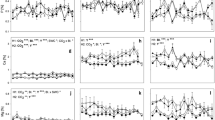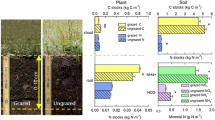Abstract
A common grass from Yellowstone National Park, Stipa occidentalis, was grown in a factorial experiment to determine if its response to the direct effects of elevated CO2 would be affected by defoliation, and urea additions simulating the N in a urine hit. Plants were grown in tall pots (to mimic rooting depth in the field) in growth chambers under elevated (700 ppm) and ambient (370 ppm) CO2, were defoliated or left undefoliated, and given N-supply rates based on field mineralization rates (untreated) or with an additional 40 g N/m2. Growth increases in response to elevated CO2 were largest when plants remained unclipped and received urea additions, and were found primarily in crowns and roots (storage organs). Aboveground biomass, which is the part of the plant consumed by grazing mammals, was not affected by elevated CO2. The elevated CO2 treatment caused a reduction in leaf percent N. However, there was a significant interaction between the CO2 and urea treatments, resulting in a larger difference in leaf percent N between urea-treated and control plants under elevated than under ambient CO2. Hence, elevations in atmospheric CO2 may cause an increase in the amount of urine-hit-induced spatial variability in temperate grasslands. Since food quantity remained largely unchanged in response to elevated CO2, and forage N content went down, grazing mammals may be negatively affected by increases in atmospheric CO2.
Similar content being viewed by others
References
Ayres MP (1993) Plant defense, herbivory, and climate change. In: Kareiva PM, Kingslover JC, Huey RB (eds) Biotic interactions and global change. Sinauer, Sunderland, Mass, pp 75–84
Bazzaz FA (1990) The response of natural ecosystems to the rising global CO2 levels. Annu Rev Ecol Syst 21: 167–196
Brown K, Higginbotham KO (1986) Effects of carbon dioxide enrichment and nitrogen supply on growth of boreal tree seedlings. Tree Physiol 2: 223–232
Chapin FS III (1980) Mineral nutrition of wild plants. Annu Rev Ecol Syst 11: 233–260
Conway TS, Tans P, Waterman LS, Thoning KW, Maserie KA, Gammon RM (1988) Atmospheric carbon dioxide measurements in the remote global troposphere, 1981–1984. Tellus 40B: 82–115
Curtis PS, Drake BG, Leadley PW, Arp W, Whigham D (1989a) Growth and senescence of plant communities exposed to elevated CO2 concentrations on an estuarine marsh. Oecologia 78: 20–26
Curtis PS, Drake BG, Whigham DF (1989b) Nitrogen and carbon dynamics in C3 and C4 marsh plants grown under elevated CO2 in situ. Oecologia 78: 297–301
Danckwerts JE, Tony A, Gordon J (1991) Reserve carbon: storage and remobilization after defoliation of 14C assimilated by Themeda triandra Forssk. IVth International Rangeland Congress, Montpellier, France
Day TA, Detling JK (1990) Grassland patch dynamics and herbivore grazing preference following urea deposition. Ecology 71: 180–188
Evans AC (1938) Physiological relationshps between insects and their host plants. I. The effect of the chemical composition of the plant on reproduction and production of winged forms in Brevicoryne brassica L. Ann Appl Biol 25: 558–571
Fajer ED, Bowers MD, Bazzaz FA (1989) The effects of enriched carbon dioxide atmospheres on plant-insect herbivore interactions. Science 243: 1198–1200
Fajer ED, Bowers MD, Bazzaz FA (1991) Performance and allocation patterns of the perennial herb, Plantago lanceloata, in response to simulated herbivory and elevated CO2 environments. Oecologia 87: 37–42
Frank DA, McNaughton SJ (1993) Evidence for the promotion of aboveground grassland production by native large herbivores in Yellowstone National Park. Oecologia 96: 157–161
Frank DA, Inouye RS, Huntly N, Minshall GW, Anderson JE (1994) The biogeochemistry of a north-temperate grassland with native ungulates: nitrogen dynamics in Yellowstone National Park. Biogeochemistry 26: 163–188
Houghton JT, Jenkins GJ, Ephraums JJ (eds) (1990) Climate change. The IPCC Scientific Assessment. Cambridge University Press, Cambridge
Jaramillo VJ, Detling JK (1992a) Small-scale heterogeneity in a semi-arid North American grassland. I. Tillering, N uptake and retranslocation in simulated urea patches. J Appl Ecol 29: 1–8
Jaramillo VJ, Detling JK (1992b) Small-scale heterogeneity in a semi-arid North American grassland. II. Cattle grazing of simulated urine patches. J Appl Ecol 29: 1–8
Larigauderie A, Hilbert DW, Oechel WC (1988) Effect of CO2 enrichment and nitrogen availability on resource acquisition and resource allocation in a grass, Bromus mollis. Oecologia 77: 544–549
Lincoln DE, Couvet D, Sionit N (1986) Response of an insect herbivore to host plants grown in carbon dioxide enriched atmospheres. Oecologia 69: 556–560
Lincoln DE, Fajer ED, Johnson RH (1993) Plant-insect herbivore interactions in elevated CO2 environments. Trees 8: 64–68
Loehle C (1995) Anomalous responses of plants to CO2 enrichment. Oikos 73: 181–187
Mattson W (1980) Herbivory in relation to plant nitrogen content. Annu Rev Ecol Syst 11: 119–161
McNaughton SJ (1985) Ecology of a grazing ecosystem: the Serengeti. Ecol Monogr 55: 259–294
McNaughton SJ (1990) Mineral nutrition and seasonal movements of African migratory ungulates. Nature 345: 613–615
McNaughton SJ (1992) Laboratory-simulated grazing: interactive effects of defoliation and canopy closure on Serengeti grasses. Ecology 73: 170–183
McNaughton SJ, Ruess RW, Seagle SW (1988) Large mammals and process dynamics in African ecosystems. Bioscience 38: 794–800
Mooney HA, Drake BG, Luxmoore RJ, Oechel WC, Pitelka LF (1991) Predicting ecosystem responses to elevated CO2 concentration. Bioscience 41: 96–104
Oesterheld M, McNaughton SJ (1988) Intraspecific variation in the response of Themeda triandra to defoliation: the effect of time of recovery and growth rates on compensatory growth. Oecologia 77: 181–186
Owensby CE, Coyne PI, Auen LM (1993) Nitrogen and phosphorous dynamics of a tallgrass prairie ecosystem exposed to elevated carbon dioxide. Plant Cell Environ 16: 843–850
Patterson DT, Flint EP (1982) Interacting effects of CO2 and nutrient concentration. Weed Sci 30: 389–394
Poorter H (1993) Intraspecific variation in the growth response of plants to an elevated ambient CO2 concentration. Vegetatio 104/105: 77–97
Robbins CT (1983) Wildlife feeding and nutrition. Academic Press, London
Ruess RW, McNaughton SJ (1988) Ammonia volatilization and the effects of large grazing mammals on nutrient loss from East African grasslands. Oecologia 77: 382–386
Shantz HL (1954) The place of grasslands in the carth's vegetation cover. Ecology 35: 142–145
Slansky F, Feeny P (1977) Stabilization of the rate of nitrogen accumulation by larvae of the cabbage butterfly on wild and cultivated food plants. Ecol Monogr 47: 209–228
Steinauer EM, Collins SL (1995) Effects of urea deposition on small-scale patch structure in prairie vegetation. Ecology 76: 1195–1206
Stillwell MA (1983) Effects of bovine urinary nitrogen on the nitrogen cycle of a shortgrass prairie. PhD dissertation, Colorado State University, Fort Collins
VanSoest PJ (1982) Nutritional ecology of the ruminant. Cornell University Press, Ithaca
Wigley TML, Raper SCB (1992) Implications for climate and sea level of revised IPCC emissions scenarios. Nature 357: 293–300
Wilsey BJ (1995) Effects of elevated CO2 on plant-grazer interactions. PhD dissertation, Syracuse University
Wilsey BJ (1996) Plant response to elevated CO2 among terrestrial biomes. Oikos 76:201–209
Wilsey BJ, McNaughton SJ, Coleman JS (1994) Will increases in atmospheric CO2 affect regrowth following grazing in C4 grasses from tropical grasslands? A test with Sporobolus kentrophyllus. Oecologia 99: 141–144
Wong SC (1979) Elevated atmospheric partial pressures of CO2 and plant growth. I. Interactions of nitrogen and plant growth. Oecologia 44: 68–74
Zangerl AR, Bazzaz RA (1984) The response of plants to elevated CO2. II. Competitive interactions among annual plants under varying light and nutrients. Oecologia 62: 412–417
Author information
Authors and Affiliations
Rights and permissions
About this article
Cite this article
Wilsey, B.J. Urea additions and defoliation affect plant responses to elevated CO2 in a C3 grass from Yellowstone National Park. Oecologia 108, 321–327 (1996). https://doi.org/10.1007/BF00334657
Received:
Accepted:
Issue Date:
DOI: https://doi.org/10.1007/BF00334657




